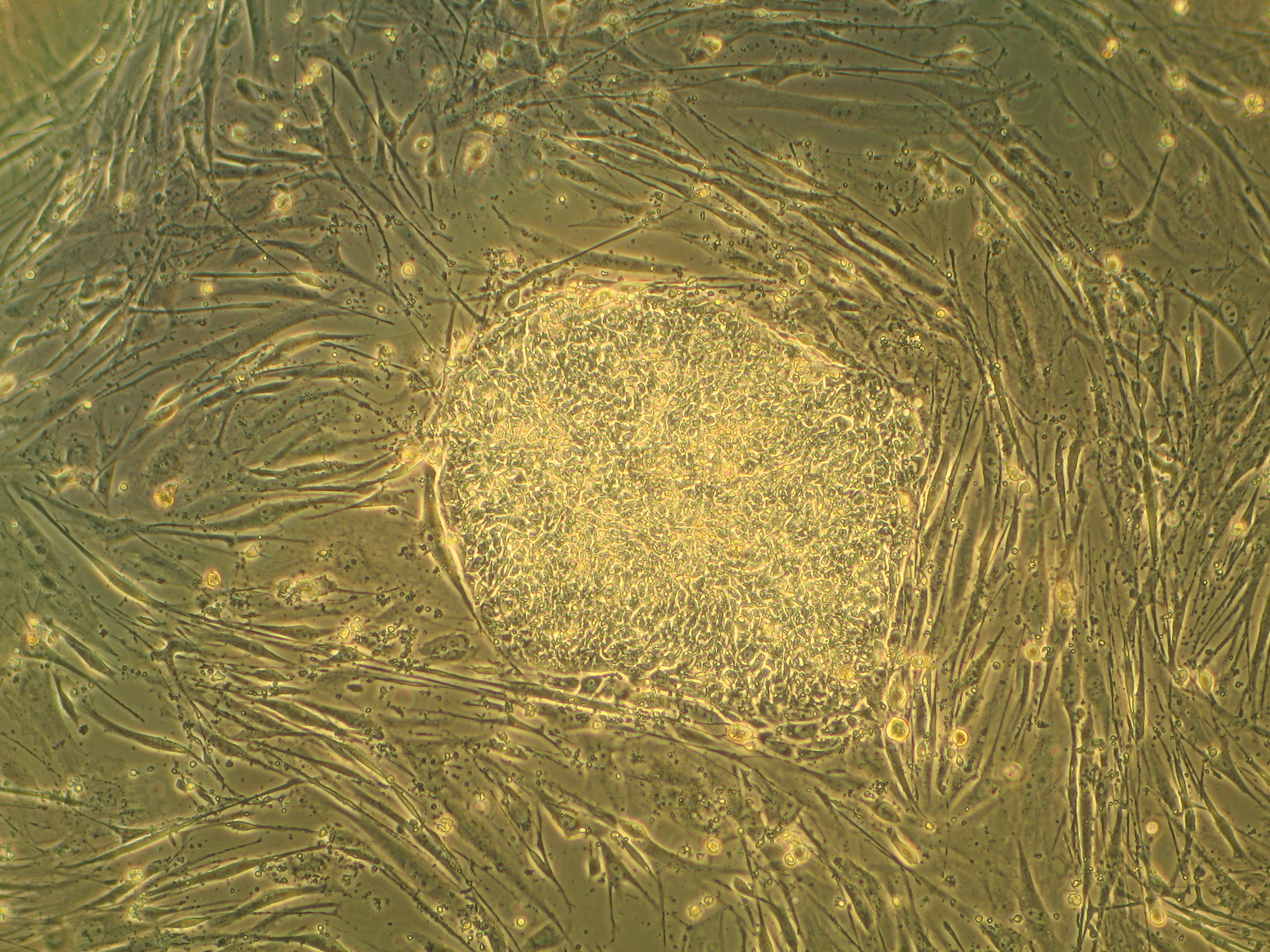mouse embryonic fibroblast on:
[Wikipedia]
[Google]
[Amazon]

 Mouse Embryonic Fibroblasts (MEFs) are a type of
Mouse Embryonic Fibroblasts (MEFs) are a type of

fibroblast
A fibroblast is a type of biological cell that synthesizes the extracellular matrix and collagen, produces the structural framework ( stroma) for animal tissues, and plays a critical role in wound healing. Fibroblasts are the most common cells o ...
prepared from mouse embryo
An embryo is an initial stage of development of a multicellular organism. In organisms that reproduce sexually, embryonic development is the part of the life cycle that begins just after fertilization of the female egg cell by the male sperm ...
. MEFs show a spindle shape when cultured ''in vitro
''In vitro'' (meaning in glass, or ''in the glass'') studies are performed with microorganisms, cells, or biological molecules outside their normal biological context. Colloquially called " test-tube experiments", these studies in biology ...
'', a typical feature of fibroblasts.
The MEF is a limited cell line. After several transmission, MEFs will senesce and finally die off. Nevertheless, researchers can use several strategies, like virus
A virus is a submicroscopic infectious agent that replicates only inside the living cells of an organism. Viruses infect all life forms, from animals and plants to microorganisms, including bacteria and archaea.
Since Dmitri Ivanovsky' ...
infection or repeated transmission to immortalize MEF cells, which can let MEFs grown indefinitely in spite of some changes in characters.
MEFs are widely used in life science researches, especially in stem cell
In multicellular organisms, stem cells are undifferentiated or partially differentiated cells that can differentiate into various types of cells and proliferate indefinitely to produce more of the same stem cell. They are the earliest type of ...
biology.
Preparation and culture
To prepare MEFs, pregnant female mice are needed. After killing the female mouse, the researcher should incise its stomach and then detach the embryo from theplacenta
The placenta is a temporary embryonic and later fetal organ that begins developing from the blastocyst shortly after implantation. It plays critical roles in facilitating nutrient, gas and waste exchange between the physically separate mat ...
in a biohazard hood. Then the liver
The liver is a major organ only found in vertebrates which performs many essential biological functions such as detoxification of the organism, and the synthesis of proteins and biochemicals necessary for digestion and growth. In humans, it ...
and head should be taken out. Finally digest the remains by enzymes to obtain single isolated cells and culture the cells in a tissue culture
Tissue culture is the growth of tissues or cells in an artificial medium separate from the parent organism. This technique is also called micropropagation. This is typically facilitated via use of a liquid, semi-solid, or solid growth medium, su ...
dishes. MEF cells can be cultured ''in vitro'' in DMEM
Minimal Essential Medium (MEM) is a synthetic cell culture medium developed by Harry Eagle first published in 1959 in ''Science'' that can be used to maintain cells in tissue culture. It is based on 6 salts and glucose described in Earle's salts ...
medium with 10% FBS. To transmit MEFs, researches should use trypsin
Trypsin is an enzyme in the first section of the small intestine that starts the digestion of protein molecules by cutting these long chains of amino acids into smaller pieces. It is a serine protease from the PA clan superfamily, found in the di ...
to digest the cells (making them detach from the surface) and transmit 1/5 cells digested into a new dish.
Application in biology
In 1962, George Todaro and Howard Green, two researchers inNew York University
New York University (NYU) is a private research university in New York City. Chartered in 1831 by the New York State Legislature, NYU was founded by a group of New Yorkers led by then-Secretary of the Treasury Albert Gallatin.
In 1832, t ...
, immortalized MEFs by repeated transmission. These cells developed into the commonly used cell line NIH 3T3
The National Institutes of Health, commonly referred to as NIH (with each letter pronounced individually), is the primary agency of the United States government responsible for biomedical and public health research. It was founded in the late 1 ...
.
MEFs treated by mitomycin or gamma rays (such treatment makes MEF stop mitosis
In cell biology, mitosis () is a part of the cell cycle in which replicated chromosomes are separated into two new nuclei. Cell division by mitosis gives rise to genetically identical cells in which the total number of chromosomes is maintai ...
) are widely used as feeder in embryonic stem cell
Embryonic stem cells (ESCs) are pluripotent stem cells derived from the inner cell mass of a blastocyst, an early-stage pre- implantation embryo. Human embryos reach the blastocyst stage 4–5 days post fertilization, at which time they consis ...
culture because they can mimic the microenvironment in embryo.
In 2006, Shinya Yamanaka
is a Japanese stem cell researcher and a Nobel Prize laureate. He serves as the director of Center for iPS Cell ( induced Pluripotent Stem Cell) Research and Application and a professor at the Institute for Frontier Medical Sciences at Kyot ...
reprogrammed MEFs into iPSCs by introducing 4 factors, which is remarkable in the development of stem cell biology.
See also
*Fibroblast
A fibroblast is a type of biological cell that synthesizes the extracellular matrix and collagen, produces the structural framework ( stroma) for animal tissues, and plays a critical role in wound healing. Fibroblasts are the most common cells o ...
*Embryonic stem cell
Embryonic stem cells (ESCs) are pluripotent stem cells derived from the inner cell mass of a blastocyst, an early-stage pre- implantation embryo. Human embryos reach the blastocyst stage 4–5 days post fertilization, at which time they consis ...
References
{{reflist, 2 Rodent cell lines